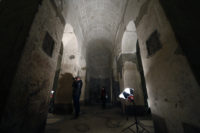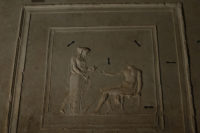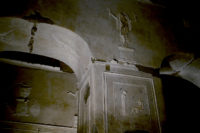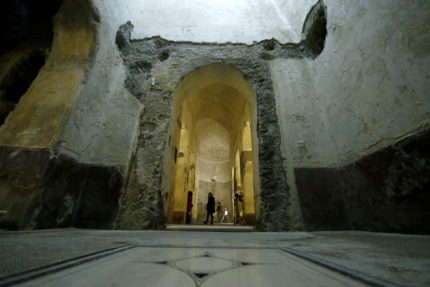 The earliest known religious basilica was a secret when it was first built in the 1st century A.D. It was ingenious constructed entirely underground by digging out the forms of the walls and pillars from the soft volcanic tufa, pouring concrete into them and then cutting away the tufa. They poured arches for the barrel vaulted and dome ceilings over the pillars and then cut out all the tufa left in the interior to create a basilica just like the ones used as public buildings above ground.
The earliest known religious basilica was a secret when it was first built in the 1st century A.D. It was ingenious constructed entirely underground by digging out the forms of the walls and pillars from the soft volcanic tufa, pouring concrete into them and then cutting away the tufa. They poured arches for the barrel vaulted and dome ceilings over the pillars and then cut out all the tufa left in the interior to create a basilica just like the ones used as public buildings above ground.
The public ones were used to do business, commercial, legal and governmental. It wasn’t until Constantine that the basilica design was used for the first churches in the 4th century. The one exception is this remarkable structure just outside the ancient walls of Rome at the Porta Maggiore. To this day we don’t know what exactly the space was used for. The mythology-heavy stucco reliefs and architectural proportions (all measurements relate to the number three) indicate it may have been a cult site for a Neopythagorean mystery religion. The dating of the mosaic floor indicate it two construction periods, one under Augustus, the second under Claudius.
 When I first wrote about the magical mystery wonderland that is the Basilica Sotteranea at the Porta Maggiore in Rome, it had just opened to the public after 12 years of restoration. Visitors were allowed for the first time in decades to descend 30 feet under the Via Praenestina into the dromos, the long entrance gallery, and the atrium. They could gaze in away at the soaring walls decorated with delicate stucco figures and scenes from mythology and the barrel and dome vaults topping them.
When I first wrote about the magical mystery wonderland that is the Basilica Sotteranea at the Porta Maggiore in Rome, it had just opened to the public after 12 years of restoration. Visitors were allowed for the first time in decades to descend 30 feet under the Via Praenestina into the dromos, the long entrance gallery, and the atrium. They could gaze in away at the soaring walls decorated with delicate stucco figures and scenes from mythology and the barrel and dome vaults topping them.
Because of the complex environmental needs of the space — its structure and ornamentation is highly susceptible to heat, moisture and microorganism growth — only guided tours were allowed on the second and fourth Sundays of the month, reservations required. Alas, when I visited Rome two years later, the Basilica Sotterranea was no longer open. Now I  know why: it was busily engaged in the next stages of conservation. Funded by the Swiss historic preservation non-profit Fondation Evergète, the vaults and apses have received much-needed attention. The entire north wall from floor to ceiling of the left nave has been restored to its stunning pristine whiteness.
know why: it was busily engaged in the next stages of conservation. Funded by the Swiss historic preservation non-profit Fondation Evergète, the vaults and apses have received much-needed attention. The entire north wall from floor to ceiling of the left nave has been restored to its stunning pristine whiteness.
Restoration is ongoing and the basilica is still an active worksite. Visitors are welcomed in the new “didactic room” in the atrium, where augmented reality visors will give people the opportunity to see the stucco reliefs and frescoes up close. On the agenda for 2020 is the full conservation of the south wall of the left nave and the installation of a new lighting system to illuminate the wall decorations.
This exceptional space has a lot in common with the Domus Aurea — dark, soaring underground spaces, fragile decorations, mythology, mosaics, endemic danger from water and invasive organisms — and that tour was such an awesome experience I did it two years in a row. Guided tours of the Basilica Sotterranea di Porta Maggiore run at 11AM on the 2nd, 3rd and 4th Sunday of the month and are available in Italian only. Tickets can be purchased online here.
